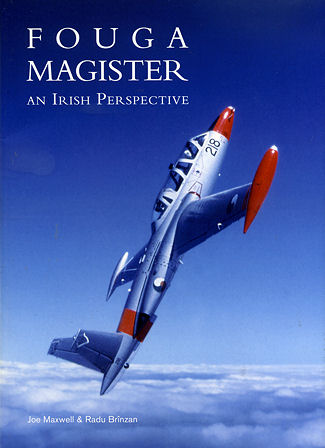Max Decals - Fouga Magister: An Irish Perspective
|
BY: |
Joe Maxwell and Radu Brinzan |
|
PUBLISHER
/PRICE: |
Max Decals
22 Euros |
|
REVIEW BY: |
Scott
Van Aken |
|
NOTES: |
108 pages, Softbound, A4 Format
ISBN 978-0-9562624-1-7 |
 I
generally like surprises, especially if they are nice ones and I got one a short
time back when this first book effort from Max Decals arrived at my door. The
book itself was superbly packaged to prevent any damage and so it arrived in
perfect order.
I
generally like surprises, especially if they are nice ones and I got one a short
time back when this first book effort from Max Decals arrived at my door. The
book itself was superbly packaged to prevent any damage and so it arrived in
perfect order.
As mentioned, this is Max Decals' first book
effort and they have chosen one of the longest operating aircraft of the Irish
Air Corps, the Fouga Magister. Now this is not a history of the Magister in
world operations, but keys in on the Magister as used by Ireland. Of course, the
book begins with a history of the Magister in terms of its development as well
as on attempts to start an aviation industry in Ireland after WWII.
Then we get into information on the
aircraft that were eventually to see IAC service.
Of course, the IAC did not just say, 'we want Magisters'
but did a lot of looking around to find planes to replace its long used Vampire
T.55s. In fact things were getting close as the Vampires were quickly running
out of fatigue life. There were several choices, including the T-37, Jet
Provost, and MB.326, but the Magisters were the only ones being offered as
second hand, though to be refurbished to new condition, and were at a price the
Irish could afford.
Some of the planes were those that were destined
for the breakaway province of Katanga in the early 1960s but were unable to be
delivered. There is a considerable section on the operation of those Magisters
that did reach Katanga and it includes some rare photos of Katanganese aircraft
that I have never seen before. It also includes more information on the UN
involvement, which features the operations of the Irish contingent in Katanga, a
place where the Irish first met the Magister, though on the receiving end of
things!
The book then goes into the drawn out delays in
delivery of the six aircraft that were purchased, much of the delay caused by
the French company that was doing the refurbishment. They did a poor job and
basically did not finish out the contract, with the work going to another French
company who did this sort of work for the Armee d'l Air.
We then go into a section on flying the aircraft
then into a goodly part on the IAC's Silver Swallows display team. This section
includes diagrams of most of the maneuvers performed by the team as well as the
places where they performed international displays. This is followed on a
section regarding the maintenance of the aircraft and here we have a
'walk-around' of the airframe showing the various parts of the aircraft; a
section modelers should very much appreciate.
The last section is on the winding down of
Magister operations and the eventual fate of extant airframes. One of them,
which was originally Austrian, ended up in the Austrian Air Force Museum while
the others were given to various Irish technical institutes as teaching aids or
kept for eventual display in Ireland. This section also includes the story of
looking for and deciding on a replacement for the Magister, which was to be the
PC-9M.
In all, it makes for an outstanding book and a
superlative initial book. It is well worth picking up and one that I can easily
give my highest recommendation.
Review sample courtesy of
Max Decals and you can go
here for more information.
October 2012
If you would like your product reviewed fairly and
fairly quickly, please contact the editor or see other details in the
Note to
Contributors.
 I
generally like surprises, especially if they are nice ones and I got one a short
time back when this first book effort from Max Decals arrived at my door. The
book itself was superbly packaged to prevent any damage and so it arrived in
perfect order.
I
generally like surprises, especially if they are nice ones and I got one a short
time back when this first book effort from Max Decals arrived at my door. The
book itself was superbly packaged to prevent any damage and so it arrived in
perfect order.